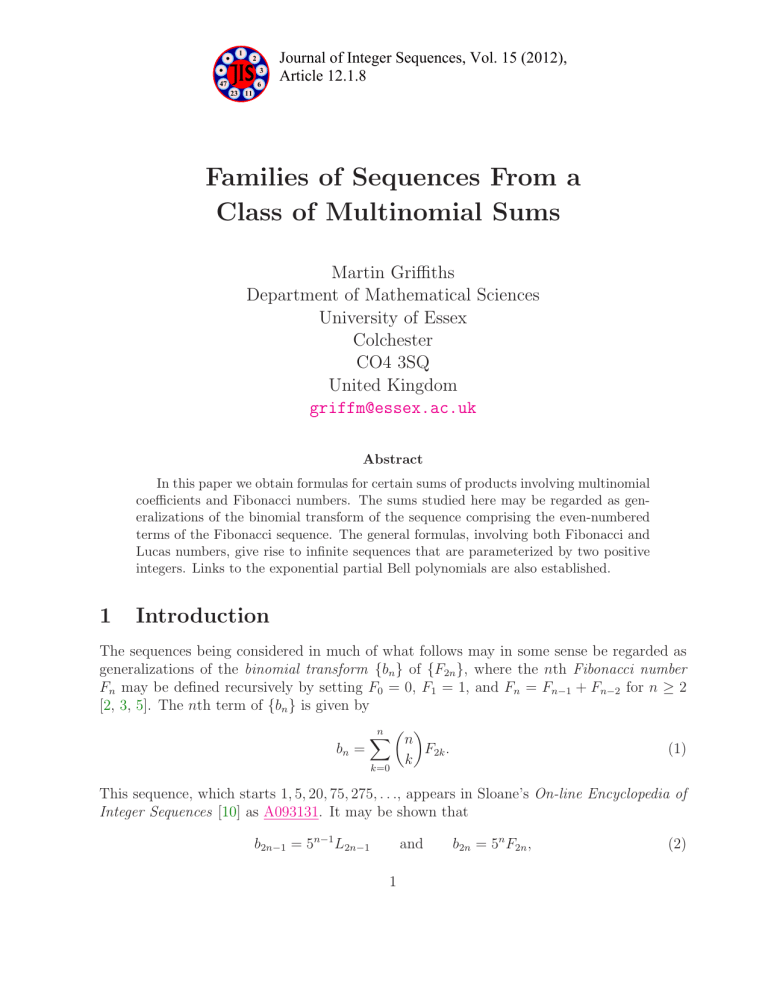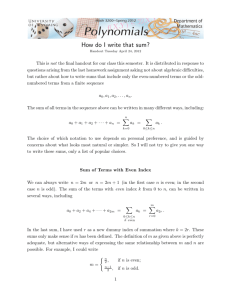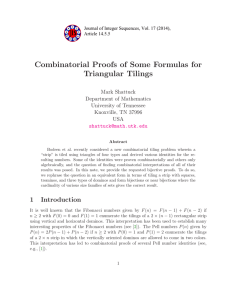Families of Sequences From a Class of Multinomial Sums
advertisement

1
2
3
47
6
Journal of Integer Sequences, Vol. 15 (2012),
Article 12.1.8
23 11
Families of Sequences From a
Class of Multinomial Sums
Martin Griffiths
Department of Mathematical Sciences
University of Essex
Colchester
CO4 3SQ
United Kingdom
griffm@essex.ac.uk
Abstract
In this paper we obtain formulas for certain sums of products involving multinomial
coefficients and Fibonacci numbers. The sums studied here may be regarded as generalizations of the binomial transform of the sequence comprising the even-numbered
terms of the Fibonacci sequence. The general formulas, involving both Fibonacci and
Lucas numbers, give rise to infinite sequences that are parameterized by two positive
integers. Links to the exponential partial Bell polynomials are also established.
1
Introduction
The sequences being considered in much of what follows may in some sense be regarded as
generalizations of the binomial transform {bn } of {F2n }, where the nth Fibonacci number
Fn may be defined recursively by setting F0 = 0, F1 = 1, and Fn = Fn−1 + Fn−2 for n ≥ 2
[2, 3, 5]. The nth term of {bn } is given by
n X
n
F2k .
(1)
bn =
k
k=0
This sequence, which starts 1, 5, 20, 75, 275, . . ., appears in Sloane’s On-line Encyclopedia of
Integer Sequences [10] as A093131. It may be shown that
b2n−1 = 5n−1 L2n−1
and
1
b2n = 5n F2n ,
(2)
where Ln , the nth Lucas number, is defined by L0 = 2, L1 = 1 and Ln = Ln−1 + Ln−2 for
n ≥ 2.
Our generalization leads us to study certain sums of products involving multinomial
coefficients and Fibonacci numbers. These give rise to sequences parameterized by two
positive integers, s and t. In other words, each pair (s, t) is associated with a particular
infinite sequence. Note, by way of contrast, that {bn } does not possess any parameters. A
further result concerning 1-parameter sequences is then derived. Finally, we go on to obtain
some results associated with our sequences, including one in connection with the exponential
partial Bell polynomials.
2
Some general results
Throughout this paper we use the notation
n
a0 , a2 , . . . , at−1
to represent the multinomial coefficient [6]
(a0 + a2 + · · · + at−1 )!
,
a0 !a1 ! · · · at−1 !
where each ai , i = 0, 1, . . . , t − 1, is a non-negative integer such that n = a0 + a1 + · · · + at−1 .
The binomial coefficients correspond to the special case t = 2.
Furthermore, we shall find it useful to extend the definition of the Fibonacci numbers
to negative subscripts as in [5]. This may be achieved by rearranging the Fibonacci recurrence relation to give Fn−2 = Fn − Fn−1 and then using it in a recursive manner for
n = 1, 0, −1, −2 . . .. From this we obtain F−1 = F1 − F0 = 1, F−2 = F0 − F−1 = −1, and so
on. It is in fact straightforward to show that for any n ∈ N,
F−n = (−1)n+1 Fn .
(3)
In order to obtain some of the results that follow, we will, at appropriate points, introduce
and utilize various mathematical properties of the golden ratio φ [4, 5, 6], where
√
1+ 5
φ=
.
2
We shall have cause to make frequent use of the result
φj = Fj φ + Fj−1 ,
(4)
which is given in [5, 6]. This may be proved by induction using the Fibonacci recurrence
relation and the fact that φ2 = φ + 1. Note, by virtue of (3) and the result φ1 = φ − 1, that
(4) is valid for all j ∈ Z. Similarly, we may obtain
L−n = (−1)n Ln
2
(5)
and
√
5 φj = Lj φ + Lj−1 .
(6)
Result (6) appears in [5] and, as with (4), is valid for all j ∈ Z.
In Theorem 2 below, use shall be made of the following simple Lemma concerning irrational numbers in general:
Lemma 1. For any irrational number α and p, q, r, s ∈ Q, pα + r = qα + s if, and only if,
p = q and r = s.
Proof. Suppose that pα + r = qα + s. If p = q then it is clear that r = s. Let us assume,
therefore, that p 6= q. We then can write
α=
s−r
∈ Q.
p−q
This, however, is a contradiction since α is irrational. It must thus be the case that pα + r =
qα + s implies p = q and r = s. The converse is obviously true, thereby proving the
lemma.
Theorem 2.
where
X
n
F4km
n
,
Fu1 (k,m) = F2kn(2m−1)
F2k
a0 , a1 , . . . , a2m−1
u1 (k, m) = 4k (a1 + 2a2 + · · · + (2m − 1)a2m−1 )
and the summation is to be taken over all possible ai ≥ 0, i = 0, 1, 2, . . . , 2m − 1, such that
a0 + a1 + · · · + a2m−1 = n.
Proof. First, let
g(s, t) = 1 + φ2s + φ4s + · · · + φ2s(t−1)
=
t−1
X
φ2js ,
j=0
where s, t ∈ N such that t ≥ 2. Then, on using (4), it follows that for any n ∈ N we have
X
a1 8k a2
a2m−1
n
n
φ4k
φ
· · · φ4k(2m−1)
[g(2k, 2m)] =
a0 , a1 , . . . , a2m−1
X
n
(7)
φ4k(a1 +2a2 +···+(2m−1)a2m−1 )
=
a0 , a1 , . . . , a2m−1
X
n
=
(8)
Fu1 (k,m) φ + Fu1 (k,m)−1 ,
a0 , a1 , . . . , a2m−1
where u1 (k, m) is as in the statement of the theorem, and the summation is to be taken over
all possible ai ≥ 0, i = 0, 1, 2, . . . , 2m − 1, such that a0 + a1 + · · · + a2m−1 = n.
3
Next, on using the formula for the sum of a finite geometric progression [9], we have
t
(φ2s ) − 1
g(s, t) = 2s
φ −1
φst (φst − φ−st )
= s s
φ (φ − φ−s )
st
φ − φ−st
s(t−1)
.
=φ
φs − φ−s
(9)
From Binet’s formula [2, 3, 4, 5, 6]
1
Fj = √
5
1
φj − −
φ
j !
and the corresponding formula for the Lucas numbers [2, 4]
j
1
j
Lj = φ + −
φ
we may obtain the result
j
φ −φ
−j
(√
5 Fj ,
=
Lj ,
if j is even;
if j is odd.
(10)
This implies, by way of (9), that
g(2k, 2m) = φ2k(2m−1)
F4km
,
F2k
and hence, using (4), that
n
2kn(2m−1)
[g(2k, 2m)] = φ
F4km
F2k
n
= φF2kn(2m−1) + F2kn(2m−1)−1
(11)
F4km
F2k
n
.
(12)
The theorem then follows from (8), (12) and Lemma 1 with α = φ.
In the following corollary we show how to generalize the result from Theorem 2 yet
further:
Corollary 3. For any j ∈ Z,
n
X
F4km
n
Fu1 (k,m)+j = F2kn(2m−1)+j
,
a0 , a1 , . . . , a2m−1
F2k
where the notation is identical to that used in the statement of Theorem 2.
4
Proof. From (7) and (11), we obtain
n
X
F4km
n
4k(a1 +2a2 +···+(2m−1)a2m−1 )
2kn(2m−1)
φ
=φ
.
a0 , a1 , . . . , a2m−1
F2k
Both sides of this equality are then multiplied by φj for some j ∈ Z, and the result follows
from (4) and Lemma 1.
Similarly, (9) and (10) give
g(2k − 1, 2m) = φ
(2k−1)(2m−1)
√
5 F2m(2k−1)
,
L2k−1
(13)
F2k(2m−1)
,
F2k
L(2k−1)(2m−1)
.
g(2k − 1, 2m − 1) = φ2(2k−1)(m−1)
L2k−1
g(2k, 2m − 1) = φ4k(m−1)
(14)
(15)
On obtaining the multinomial expansions for [g(2k, 2m − 1)]n and [g(2k − 1, 2m − 1)]n , using
(14) and (15), and then employing a similar idea to that utilized in Corollary 3, we have the
following results:
X
F2k(2m−1) n
n
Fu3 (k,m)+j = F4kn(m−1)+j
(16)
a0 , a1 , . . . , a2m−2
F2k
and
where
and
L(2k−1)(2m−1) n
n
Fu4 (k,m)+j = F2n(2k−1)(m−1)+j
,
a0 , a1 , . . . , a2m−2
L2k−1
X
(17)
u3 (k, m) = 4k (a1 + 2a2 + · · · + (2m − 2)a2m−2 )
u4 (k, m) = 2(2k − 1) (a1 + 2a2 + · · · + (2m − 2)a2m−2 ) .
√
The presence of the factor 5 in (13) means that, in order to use Lemma 1, a slightly
different treatment is required. We use (4) and (6) to obtain
√ (2n−1)(2k−1)(2m−1) F2m(2k−1) 2n−1
2n−1
n−1
[g(2k − 1, 2m)]
=5
5φ
L2k−1
F2m(2k−1) 2n−1
n−1
=5
L(2n−1)(2k−1)(2m−1) φ + L(2n−1)(2k−1)(2m−1)
L2k−1
and
2n
[g(2k − 1, 2m)]
n 2n(2k−1)(2m−1)
=5 φ
n
=5
F2m(2k−1)
L2k−1
2n
F2n(2k−1)(2m−1) φ + F2n(2k−1)(2m−1)
5
F2m(2k−1)
L2k−1
2n
.
These results lead to
X
F2m(2k−1) 2n−1
2n − 1
n−1
Fu2 (k,m)+j = 5 L(2n−1)(2k−1)(2m−1)+j
a0 , a1 , . . . , a2m−1
L2k−1
and
F2m(2k−1) 2n
2n
n
Fu2 (k,m)+j = 5 F2n(2k−1)(2m−1)+j
,
L2k−1
a0 , a1 , . . . , a2m−1
respectively, where
X
(18)
(19)
u2 (k, m) = 2(2k − 1) (a1 + 2a2 + · · · + (2m − 1)a2m−1 ) .
Note that a formula for the right-hand side of (1) may be obtained by considering the
n
expansion of (1 + φ2 ) = [g(1, 2)]n . The results b2n−1 = 5n−1 L2n−1 and b2n = 5n F2n given
in (2) may thus be seen to be specializations of (18) and (19), respectively. It is also worth
noting, for example, that both Identity 3 in [1] and Result (31) in [7] are specializations of
Theorem 2. The sequence arising from Identity 3 in [1] appears in [10] as A087426.
Since
X
n
Fu1 (k,m)
a0 , a1 , . . . , a2m−1
is an integer, it follows from Theorem 2 that
n
n
F2k
|F2kn(2m−1) F4km
.
Although not necessarily following from this divisibility result, it is in fact well-known that
n
Fa |Fab and hence Fan |Fab
for any a, b, n ∈ N [2]. Indeed, a similar observation may be made
regarding (16). On considering (17) we see that
Ln2k−1 |F2n(2k−1)(m−1) Ln(2k−1)(2m−1) .
Again, although not necessarily following from this, it is true, if rather less well-known, that
La |Lab for any odd positive integers a and b. Similarly, (18) and (19) hint at the possibility
that, for any odd positive integer a and even positive integer b, La |Fab . This result also
happens to be true (see [5] for a summary of such results).
Leading on from this, since
m−1
X
F2k(2m−1)
=1+
L4jk
F2k
j=1
m−1
X
L(2k−1)(2m−1)
=1+
L2j(2k−1) ,
L2k−1
j=1
and
we may in fact combine (16) and (17) to give
X
n
Fu5 (s,m)+j = F2sn(m−1)+j
a0 , a1 , . . . , a2m−2
1+
m−1
X
j=1
L2js
!n
,
where
u5 (s, m) = 2s (a1 + 2a2 + · · · + (2m − 2)a2m−2 )
We have thus combined two cases at the expense of a somewhat more unwieldy expression
on the right-hand side.
6
3
An alternative family of sequences
We now consider a family of sequences parameterized by t ∈ N such that t is even, noting
that these are not specializations of any of the sequences derived in Section 2. Let us start
by defining the expression h(t) given by
h(t) = 1 + φ + φ2 + · · · + φ(t−1) .
Then, since φ =
1
,
φ−1
we may obtain
φ4m − 1
h(4m) =
φ−1
= φ · φ2m φ2m − φ−2m
2m !
1
= φ2m+1 φ2m − −
φ
√
= φ2m+1 5 F2m ,
(20)
and similarly
h(4m − 2) = φ2m
1
φ2m−1 + −
φ
= φ2m L2m−1 .
2m−1 !
(21)
Result (20) gives rise to
X
2n − 1
2n−1
Fv1 (m)+j = 5n−1 L(2n−1)(2m+1)+j F2m
a0 , a1 , . . . , a4m−1
and
while (21) leads to
X
2n
2n
Fv1 (m)+j = 5n F2n(2m+1)+j F2m
,
a0 , a1 , . . . , a4m−1
n
Fv2 (m)+j = F2mn+j Ln2m−1 ,
a0 , a1 , . . . , a4m−3
where
X
v1 (m) = a1 + 2a2 + · · · + (4m − 1)a4m−1
and
v2 (m) = a1 + 2a2 + · · · + (4m − 3)a4m−3 .
7
(22)
4
Further results
As we now show, it is possible to express (22) in a form such that the subscripts of the
n
Fibonacci numbers are given explicitly. On treating (1 + x + x2 + · · · + xt−1 ) as a formal
power series and ignoring issues of convergence, we have
n
1 − xt
2
t−1 n
1 + x + x + ··· + x
=
1−x
n
= 1 − xt (1 − x)−n
n ∞ X
X
n
n−1+j j
t i
=
x.
−x
i
n−1
i=0
j=0
Our aim is to find the coefficient of xr in the above product of sums. To this end, consider
the following typical term that arises when the product is expanded:
n − 1 + j ti+j
i n
x .
(−1)
i
n−1
It is clear from this that
n n−1+j
(−1)
i
n−1
i
makes a non-zero contribution to the coefficient of xr if, and only if, 0 ≤ i ≤
coefficient of xr is thus
⌊ rt ⌋
X
n − 1 + r − ti
i n
.
(−1)
n−1
i
i=0
r
t
. The
In conjunction with (22) this then leads to the result
n(4m−3) ⌊ 4m−2 ⌋
r
X
r=0
X
i=0
n n − 1 + r − i(4m − 2)
Fr+j = F2mn+j Ln2m−1
(−1)
n−1
i
i
for any j ∈ Z.
Finally, we demonstrate a connection between the results obtained in Section 2 and the
exponential partial Bell polynomials Bk,n [8, 11]. The latter are defined by way of
!n
∞
∞
X
1 X tj
tk
.
xj
Bk,n (x1 , x2 , . . .) =
k!
n! j=1 j!
k=n
There are a number of well-known results associated with these polynomials. For example,
!
∞ j n
∞
k
X
X
t
1
t
Bk,n (1, 1, 1, . . .) =
k!
n! j=1 j!
k=n
=
8
n
1 t
e −1 ,
n!
which is the exponential generating function for the nth column of the Stirling number
triangle of the second kind. Incidentally, it follows from this that
Bk,n (1, 1, 1, . . .) = S(k, n),
the Stirling number of the second kind enumerating the ways of partitioning a set of k labeled
objects into n non-empty disjoint parts. In addition, the kth Bell number Bk arises by way
of
k
X
Bk,n (1, 1, 1, . . .) = Bk .
n=1
This number enumerates all possible partitions of k labeled objects.
We obtain here the result
∞
X
Bk,2n−1 (1!, 2!, . . . , (4m)!, 0, 0, . . .)
k=2n−1
Fk+j
5n−1
2n−1
=
L2(m+1)(2n−1)+j F2m
k!
(2n − 1)!
(23)
for any j ∈ Z, noting that the left-hand side is in fact a finite sum. First, with the help of
(10):
!2n−1
∞
4m
X
X
φk
1
φj
Bk,2n−1 (1!, 2!, . . . , (4m)!, 0, 0, . . .)
=
j!
k!
(2n − 1)! j=1 j!
k=2n−1
!2n−1
4m−1
X
φ2n−1
φj
=
(2n − 1)! j=0
4m
2n−1
φ2n−1
φ −1
=
(2n − 1)!
φ−1
4n−2
2n−1
φ
=
φ2m φ2m − φ−2m
(2n − 1)!
√ 2(m+1)(2n−1)
5φ
2n−1
5n−1 F2m
.
=
(2n − 1)!
Then, on utilizing Lemma 1, (6) and the idea from Corollary 3, we obtain (23). Similarly,
∞
X
Bk,2n (1!, 2!, . . . , (4m)!, 0, 0, . . .)
k=2n
and
∞
X
k=n
5
5n
Fk+j
2n
=
F4n(m+1)+j F2m
k!
(2n)!
Bk,n (1!, 2!, . . . , (4m − 2)!, 0, 0, . . .)
Fk+j
1
= Fn(2m+1)+j Ln2m−1 .
k!
n!
Acknowledgement
The author wishes to thank the referee for a number of comments and suggestions that have
led to improvements in this paper.
9
References
[1] A. T. Benjamin, A. K. Eustis, and S. S. Plott, The 99th Fibonacci identity, Electron.
J. Combin. 15 (2008), #R34.
[2] D. Burton, Elementary Number Theory, McGraw-Hill, 1998.
[3] P. J. Cameron, Combinatorics: Topics, Techniques, Algorithms, Cambridge University
Press, 1994.
[4] G. H. Hardy and E. M. Wright, An Introduction to the Theory of Numbers, 6th ed.,
Oxford University Press, 2008.
[5] R. Knott, Fibonacci and golden ratio formulae,
http://www.maths.surrey.ac.uk/hosted-sites/R.Knott/Fibonacci/fibFormulae.html,
2011.
[6] D. E. Knuth, The Art of Computer Programming, Vol. 1, Addison-Wesley, 1968.
[7] J. W. Layman, Certain general binomial-Fibonacci sums, Fibonacci Quart. 15 (1977),
362–366.
[8] M. Mihoubi, Partial Bell polynomials and inverse relations, J. Integer Seq. 13 (2010),
Article 10.4.5.
[9] A. J. Sadler and D. W. S. Thorning, Understanding Pure Mathematics, Oxford University Press, 1987.
[10] N. J. A. Sloane (Ed.),
http://oeis.org/, 2011.
The On-Line Encyclopedia of Integer Sequences,
[11] Wikipedia contributors, Bell polynomials, Wikipedia, The Free Encyclopedia,
http://en.wikipedia.org/wiki/Bell polynomials, 2011.
2010 Mathematics Subject Classification: Primary 11B39; Secondary 05A10.
Keywords: multinomial coefficient, Fibonacci number, Lucas number, partial Bell polynomial.
(Concerned with sequences A087426 and A093131.)
Received October 6 2011; revised version received December 27 2011. Published in Journal
of Integer Sequences, December 27 2011.
Return to Journal of Integer Sequences home page.
10





